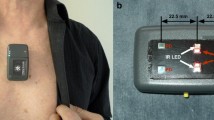Abstract
Objective. We report the off-line calculation of the vascular complianceof the finger and suggest the continuous on-line use of this methodology asan aid to monitoring the peripheral vascular resistance. This method consistsof the simultaneous analysis of the waveform signals from the pulse oximetermonitors and the arterial pressure as indicators of “volume” andpressure respectively to continuously calculate the vascular“compliance” (volume change per unit pressure change). This shouldbe seen as a “relative compliance” as the pulse plethysmographsignal is not calibrated. This new methodology allows for continuousmonitoring of peripheral vascular compliance as a beat-to-beat indicator ofperipheral vascular resistance. The vaso-constrictors, phenylephrine andephedrine, were shown to decrease the compliance as predicted. Methods. Thearterial pressure and pulse oximeter waveforms were obtained during routineanesthetic care. The waveforms were collected with a computer data-acquisitionsystem and then analyzed “off-line” as an indirect indicator oftotal vascular tone. Demographic and clinical information including drugadministration were recorded. Results. A case report is presented using thisnew form of analysis. Vascular compliance changes induced by phenylephrine andephedrine were studied. A dose response curve of peripheral vascularcompliance to phenylephrine was generated from these data. Conclusions. Byplotting the pulse oximeter waveforms versus the arterial waveforms, multiplevolume versus pressure (relative compliance) loops were obtained. Analysis ofthese loops may assist in the monitoring of vascular compliance.
Similar content being viewed by others
REFERENCES
Eichhorn JH, Cooper JB, Cullen DJ, Maier WR, Philip JH, Seeman RG. Standards for patient monitoring during anesthesia at Harvard Medical School. JAMA 1986; 256(8): 1017–1020
Pologe JA. Pulse oximetry: Technical aspects of machine design. Int Anesthesiol Clin 1987; 25(3): 137–153
Dorlas JC, Nijboer JA. Photo-electric plethysmography as a monitoring device in anaesthesia. Application and interpretation. Brit J Anaesthesia 1985; 57(5): 524–530
Kim J-M, Arakawa K, VonLintel T. Use of the pulse-wave monitor as a measurement of diagnostic sympathetic block and of surgical sympathectomy. Anesthesia and Analgesia 1975; 54(3): 289–296
Partridge BL. Use of pulse oximetry as a noninvasive indicator of intravascular volume status. J Clin Monit 1987; 3(4): 263–268
Trafford JD, Lafferty K. What does photoplethysmography measure? Med Biolog Engin Comput 1984; 22: 479–480
Fitchett D, Bouthier J, Simon A, Levenson J, Safar M. Forearm arterial compliance: The validation of a plethysmographic technique for the measurement of arterial compliance. Clin Sci 1984; 67: 69–72
Westling H, Jansson L, Jonson B, Nilsen R. Vasoactive drugs and elastic properties of human arteries in vivo, with special reference to the action of nitroglycerine. Ear Heart J 1984; 5: 609–616
Fitchett D. Forearm arterial compliance: A new measure of arterial compliance. Cardiovasc Res 1984; 18: 651–656
Dahn I, Jonson B. A plethysmographic method for determination of flow and volume pulsation in a limb. J Appl Physiol 1970; 28: 333–336
Hoffmann BB, Lefkowitz RJ. Catecholamines and sympathomimetic drugs. In: Gilman AG, Rall TW, Nies AS, Taylor P, eds. Goodman and Gilman’s The Pharmacological Basis of Therapeutics. New York: Pergamon Press, 1990: 207–214
Fitchett DH. Effecgs of vasodilator drugs on caliber and distensibility of small peripheral arteries. In: O’Rourke MF, Safar ME, Dzau VJ, eds. Arterial Vasodilation: Mechanisms and Therapy. Philadelphia: Lea & Febiger, 1993; 190–199
Shelley K, Dickstein M, Shulman S. The detection of peripheral venous pulsation using the pulse oximeter a plethysmograph. J Clin Monit 1993; 9(4): 283–287
Guyton AC. Pulmonary Ventilation. In: Guyton AC, ed. Textbook of medical physiology. Eighth Edition ed. Philadelphia, PA: W. B. Saunders Company, 1991: 402–413
Otis A. The work of breathing. In: Fenn WO, Rahn H, eds. Handbook of Physiology. Washington, D.C.: American Physiological Society, 1964: 463–476. vol I(3) Respiration
Roizen MF, Horrigan RW, Frazer BM. Anesthetic doses blocking adrenergic (stress) and cardiovascular responses to incision–MAC BAR. Anesthesiology 1981; 54: 390–398
Hamilton WK. Do let the blood pressure drop and do use myocardial depressants! Anesthesiology 1975; 45: 273–274
Murray WB, Foster PA. The peripheral pulse wave: Information overlooked. J Clin Monit 1996; 12: 365–377
Murray WB, Gorven AM. Invasive v. non-invasive blood pressure measurements: The influence of the pressure contour. S Afr Med J 1991; 79: 134–139
Author information
Authors and Affiliations
Rights and permissions
About this article
Cite this article
Shelley, K.H., Bosseau Murray, W. & Chang, D. Arterial–Pulse Oximetry Loops: A New Method of Monitoring Vascular Tone. J Clin Monit Comput 13, 223–228 (1997). https://doi.org/10.1023/A:1007361020825
Issue Date:
DOI: https://doi.org/10.1023/A:1007361020825




